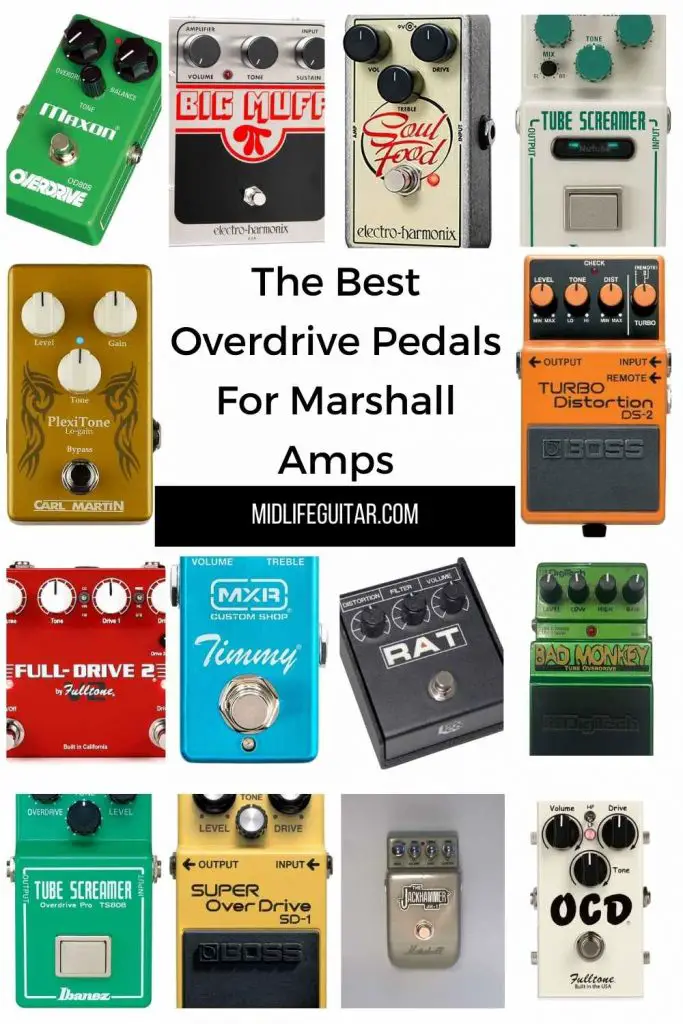
An excellent overdrive tone is the sort of thing guitar players dream about.
Ideally, an overdrive pedal should mimic the sound of a tube amplifier pushed to saturation.
Of course, we don’t all have the luxury of dining a vintage Marshall, which the flourishing industry of overdrive pedals aims to address.
Marshall amplifiers have a distinctive voice, which means some drive pedals work better with a Marshall than others. Let’s take a look at the best overdrive pedals for Marshall amps.
Related: Is Marshall Guitar Amp Good? and 13 Different Types Of Marshall Amps
1. Pro Co RAT2 Distortion Pedal
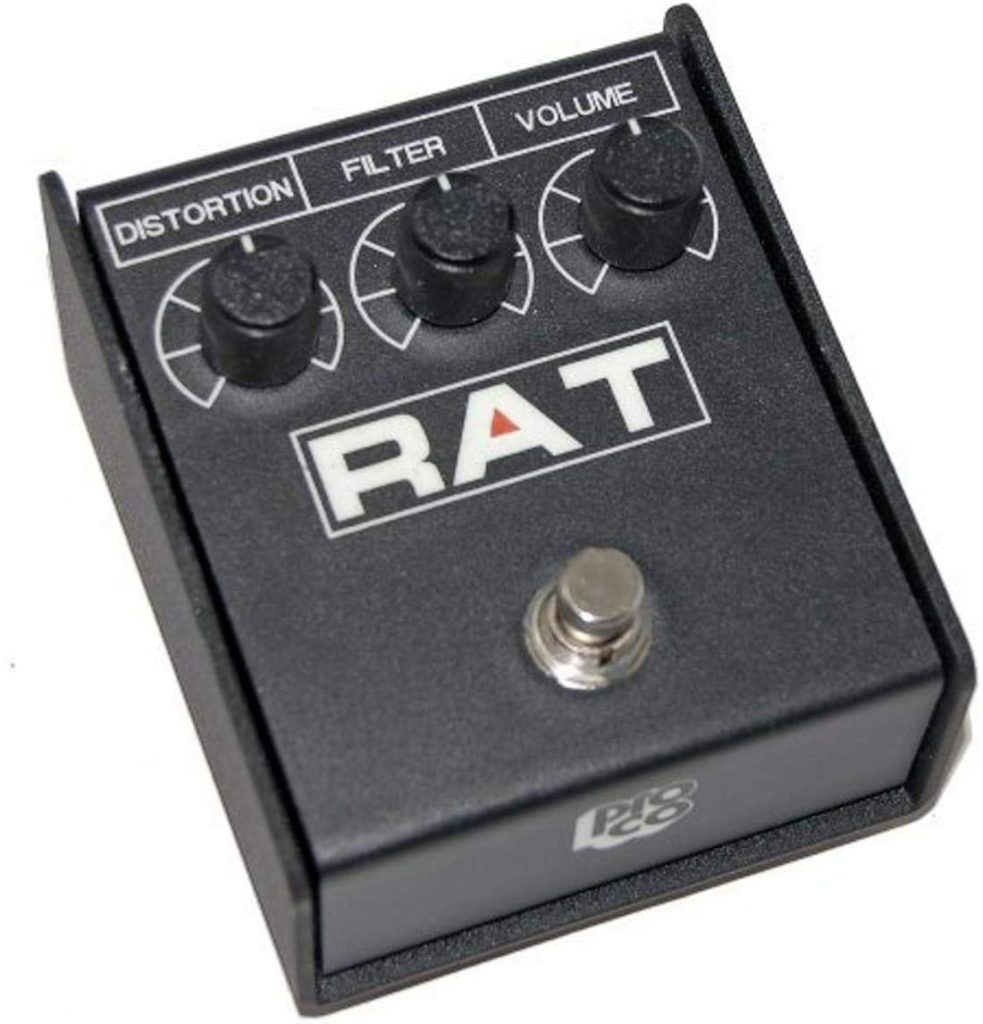
| Pros | Cons |
|---|---|
| Easy to use | Larger than most overdrive pedals |
| The only way to get that classic Rat tone | Not particularly diverse |
| High build quality | |
| Suitable for players of all abilities |
If you’re anything like me, the first thing you wanted to do when you picked up the guitar was make as much noise as possible.
The ProCo Rat is one of the world’s most famous guitar pedals, thanks in no small part to its distinctive tone.
In general, If you’re looking to dip a toe into the world of distortion pedals, the Rat is an excellent start.
With three clearly labeled knobs that control an aspect of your tone…
Dialing in tight and focused distortion sounds is as easy as stepping on your Rat and playing a power chord.
The Proco Rat will only ever sound like a Proco Rat. You’ll either love that, or you’ll hate it.
Related: In my article “Is The Proco Rat A Fuzz Pedal?” I give a thorough review of this pedal.
It takes up about twice as much space on your pedalboard as a standard Boss or MXR pedal.
The Rat is built like a tank and provides nasty, thrash metal-ready distortion at the touch of a button.
| Price: $134.49 on Amazon |
2. MXR M104 Distortion+ Pedal
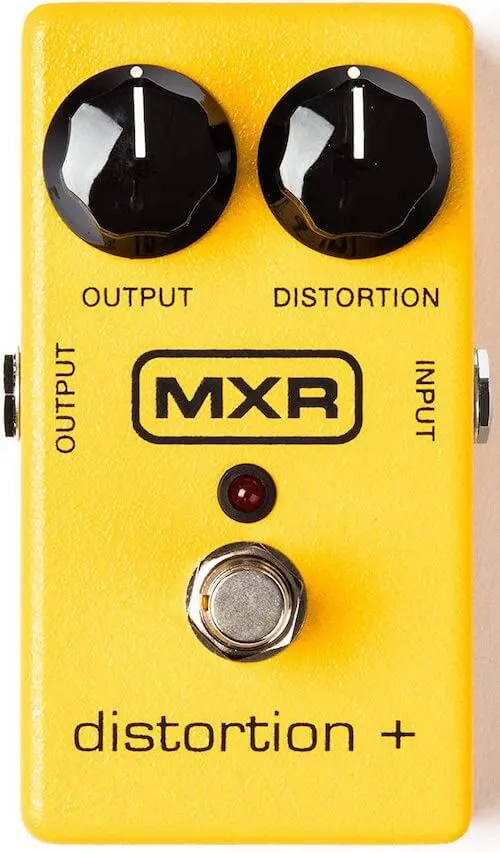
| Pros | Cons |
|---|---|
| Easy to use | Won’t provide enough saturation for players of modern metal |
| A sweet, biting tone | Can sound “buzzy” or overly trebly with some |
| High build quality | Not particularly diverse |
| Suitable for players of all abilities | |
| Distinctive yellow color | |
| Relatively cheap |
Do you want to hear what this pedal sounds like?
This YouTube video “Crazy Train” will allow you to do just that!
Randy Rhoads’ incendiary tone, thick, aggressive, and luscious, comes courtesy of his cranked Marshall and an early iteration of the MXR Distortion+.
With only two knobs and a sole footswitch, it’s easy to use and perfect for players of all abilities.
The Distortion+ provides the sort of snarling, articulate distortion you’d commonly associate with early 1980s metal.
Think Iron Maiden, Judas Priest, and, yes, those early Ozzy Osbourne albums, and you’re in the ballpark.
This nifty yellow box is about the size of an MXR Phase 90 and will send you to 80s metal Heaven.
Remember, classic pedals perform best at high volume, so be sure to play with your Distortion + when you’re sure it won’t bother the neighbors.
MXR’s famously robust construction will protect this pedal from even the most vigorous of stomps.
| Price: $79.99 on Amazon |
3. MXR Timmy Overdrive Guitar Effects Pedal
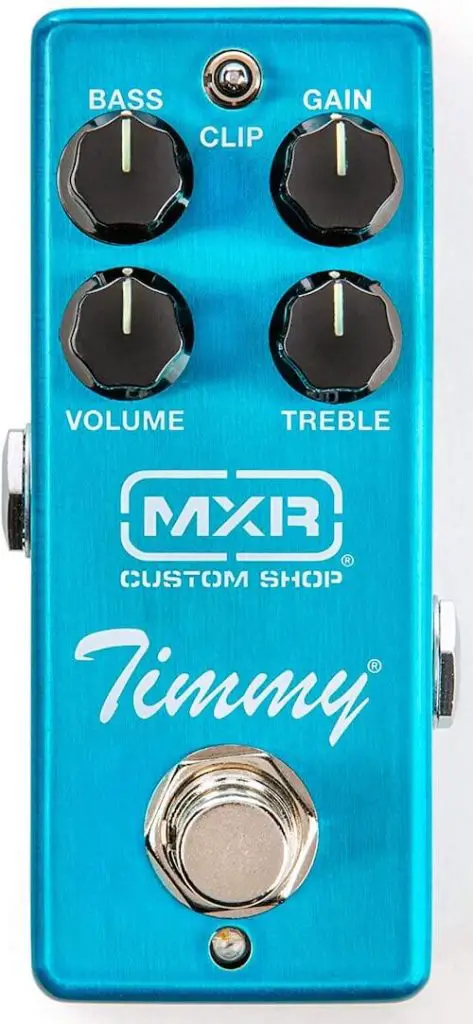
| Pros | Cons |
|---|---|
| A sweet, supple transparent overdrive pedal | Small switches can be hard to manipulate with bigger fingers |
| Rugged build quality | Requires external power. No battery slot |
| Precise tonal control |
MXR’s next entry on this list, the Timmy, is a transparent overdrive based on the legendary Klon Centaur.
It aims to accurately capture your guitar and amp’s tone with just a little extra grit.
The original Timmy, custom-built by Paul Cochrane, remains one of the highest-selling pedals online.
The Timmy might be the smallest pedal on this list, at about half the size of the MXR Distortion +…
But it is packed with the sort of classic, tubey overdrive you’ve heard on countless classic rock records.
With four knobs and a three-way clipping toggle switch, a two-band EQ, and pre-overdrive tone control, it’s a little too complex a pedal for beginners.
Intermediate players, you will adore the way Timmy enhances your natural tone, however, and its tiny footprint leaves plenty of room on the pedalboard.
Timmy will give your Marshall a pleasant push into drive without coloring your guitar’s tone.
It’s perfect for indie, country, rock, or blues players who don’t rely on a pedal for most of their sound but want a little boost for solos or power chords.
| Price: $129.99 on Amazon |
4. Carl Martin Plexitone Single Pedal
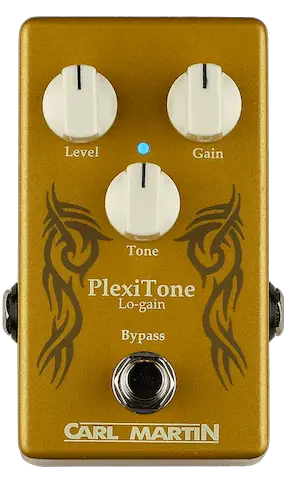
| Pros | Cons |
|---|---|
| Easy to use | Does one thing and one thing only |
| Classic Plexi tone | Can sound buzzy or fizzy in some settings |
| Durable | Not particularly diverse |
| Best suited to players looking for a Marshall tone | If you already have a Marshall, there’s no reason to buy a “Marshall in a box” pedal |
The first “boutique” pedal on this list comes from Carl Martin.
The Plexitone is a classic “amp in a box” pedal.
It aims to replicate the sound of a cranked vintage Marshall thanks to some ultra-high-tech wiring wizardry.
Because these are not mass-produced, they’re a little more expensive than the competition.
To its credit, the Plexitone, when played through a clean amp, provides a reasonably accurate simulation of the crackle and compression you’d expect from the classic Marshall sound…
And does so at a far lower volume than a cranked Marshall.
It’s about as simple to use as the Proco Rat.
However, with the gain beyond one o’clock, the sound can become fizzy and lack authority.
The Plexitone is an excellent pedal for people who need a variety of tones on tap…
But if you already own a Marshall amp, it’s somewhat redundant, as your Marshall should sound like, well, a Marshall.
| Price: $269.95 on Reverb |
5. Marshall JH-1 Jackhammer Distortion Pedal
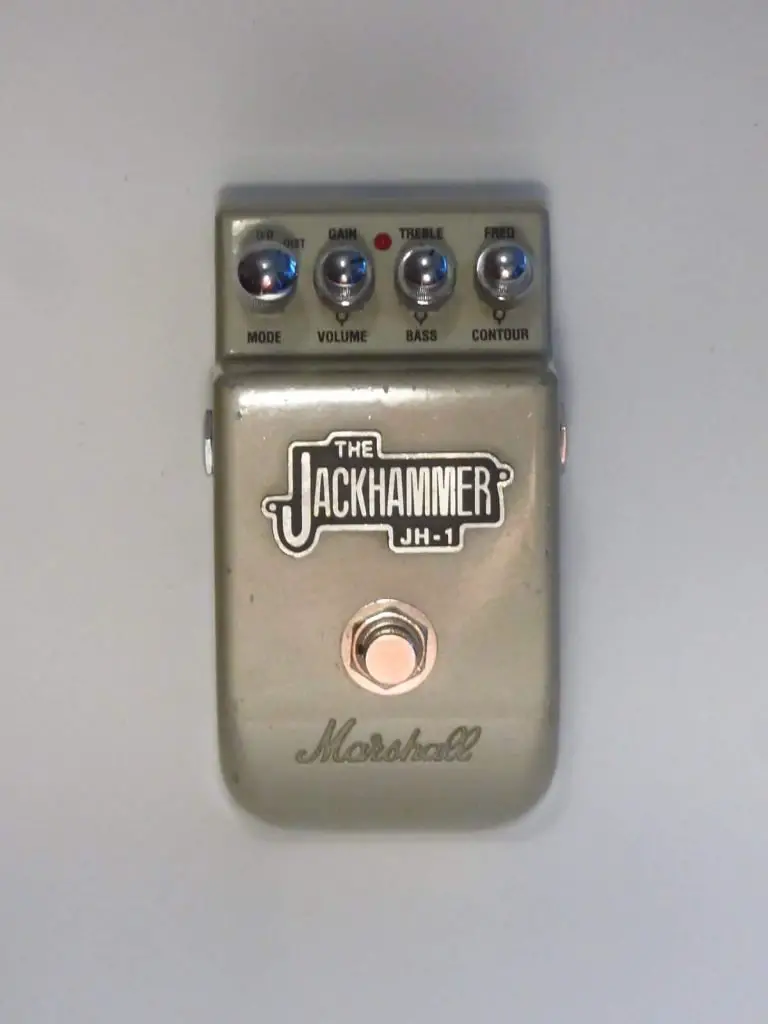
| Pros | Cons |
|---|---|
| Durable | No way to contour its darker tone |
| Massive amounts of gain available | Controls are not very sensitive |
| As it was designed to add gain to a Marshall amp, it may not play as nicely with other amps | |
| Not particularly diverse |
For all intents and purposes, the Marshall Jackhammer appears to be the iconic British brand’s answer to Spinal Tap’s “turn it up to eleven” joke.
The Jackhammer was designed to push Marshall’s amplifiers even further into saturation and does a great job of capturing the thick, luscious distortion sound of early 90s metal.
The Jackhammer, conveniently, nestles its four control knobs in a recess, so you won’t accidentally disturb your painstakingly assembled settings with an overly enthusiastic stomp.
The Jackhammer is housed in a durable metal casing.
It’s great for intermediate players looking to get more crushing distortion out of their already overdriven amp.
The Jackhammer has a famously dark sound, with minimal treble.
Shredders looking for solid note definitions should look elsewhere.
This darker tone can work well with high-treble amps such as Marshall’s classic Plexis.
However, generally speaking, if you want a vintage-style distortion, you’d be better off with a more articulate pedal like the Timmy.
| Price: The Jackhammer is out of production but typically sells for about $80-$120 used on Reverb. |
6. Fulltone Full-Drive 2 V2 Overdrive Pedal with Boost
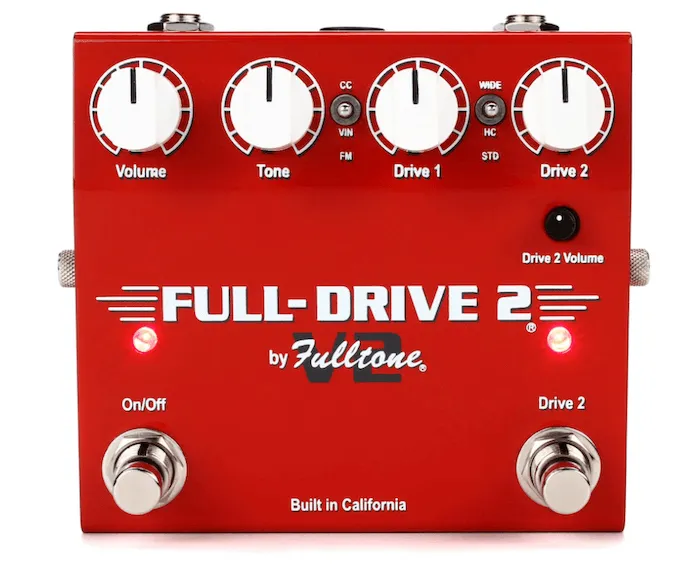
| Pros | Cons |
|---|---|
| Diverse sounds | Huge footprint. Will take up a lot of your board. |
| Easy to control | Heavy |
| Offers channel switching, allowing you to use one pedal for rhythm, lead, and clean playing | The many controls could be intimidating |
| Offers articulate, thick overdrive and creamy distortion |
Fulltone wanted to make an overdrive that covers all bases, and they certainly did that here.
With an array of excellent features such as:
- Twin drive channels,
- Starship Enterprise-worthy variety of knobs and switches, and
- A Larger footprint,
This pedal is aimed squarely at advanced players who want total tonal control.
The Fulldrive will turn a clean amp into a driven, screaming rock powerhouse, and if you choose to engage its second channel, you can drive that even further.
If you want most of your dirty tone in a pedal, this will be versatile and precisely controllable enough to do the trick.
It comes in a sturdy housing, but like the Rat occupies more than twice the space on a pedalboard of most overdrives.
It actually weighs half a kilo, which could be too heavy for a gigging guitarist who carries their own gear.
| Price: $210 on Sweetwater. |
7. DigiTech DBM Bad Monkey Tube-Overdrive Pedal
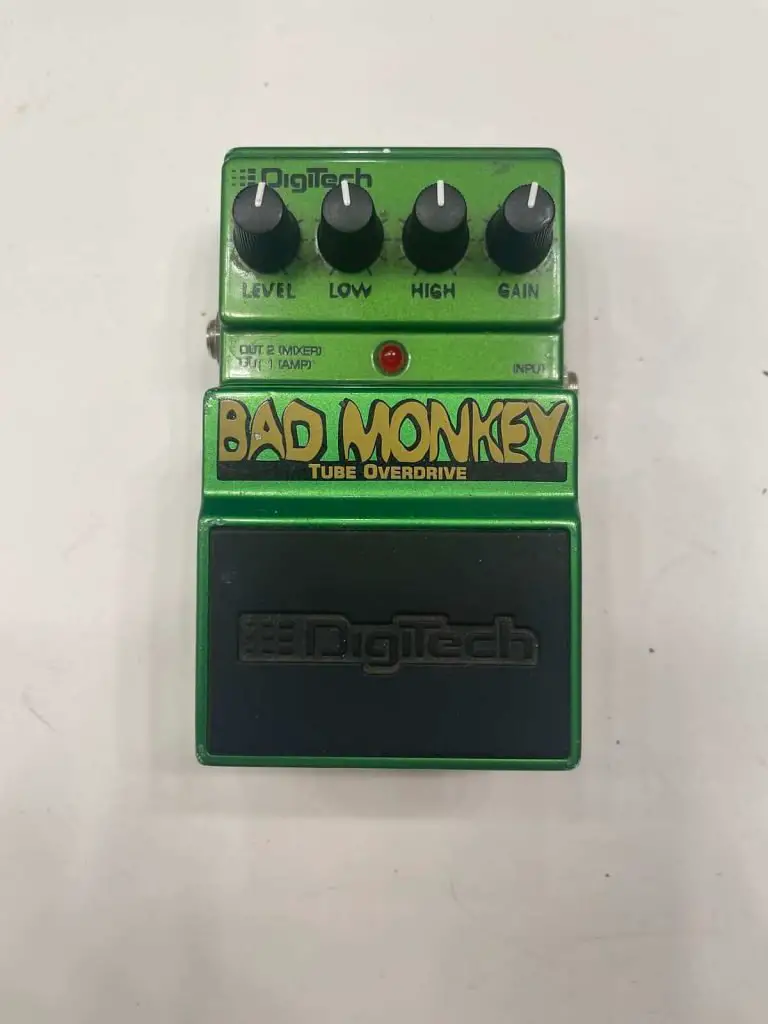
| Pros | Cons |
|---|---|
| Small footprint | EQ isn’t sensitive |
| Strong metal chassis | The distinctive character won’t be to everyone’s taste |
| Pleasant light drive tone | |
| Affordable price |
Fun fact, I once played with a punk rock band who loved this pedal so much they named a song after it.
If that isn’t a glowing endorsement, I don’t know what is.
The Bad Monkey is one of the finest Tube Screamer-type pedals on the market, and it retails for a lower price than other pedals on this list.
It’s about the size and shape of a standard Boss pedal and is made of metal.
Its EQ curve isn’t particularly sensitive, but as a primary source of overdrive, it will cut pleasantly through the mix.
Bon Jovi’s lead guitarist, Phil X, proudly plays the Bad Monkey…
But you don’t need his prodigious shredding chops to make the most of this pedal.
It’s an excellent option for intermediate players looking for a Tube Screamer-style sound with the articulate, thick mid boost for which those green Japanese boxes were so famous.
The Bad Monkey is great at adding a little grit and color to your tone.
It’s anything but transparent and won’t sound fantastic as a source of full-bore distortion…
But then, neither was the original Tube Screamer.
| Price: Out of production, but used pedals sell for about $100 on Reverb. |
8. Fulltone OCD Obsessive Compulsive Drive Pedal
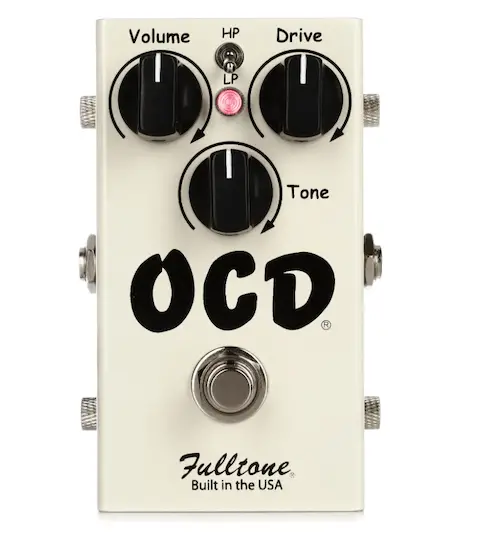
| Pros | Cons |
|---|---|
| Small footprint | Can be expensive |
| Durable build | |
| Warm, natural overdrive | |
| Preserves picking dynamics |
The second transparent drive on our list is the Fulltone OCD.
This pedal, when engaged, has the miraculous ability to make your Marshall sound louder without being louder…
In fact, You can hear the pick hitting the strings.
Palm-muting sounds chunky and articulate with this pedal.
Remarkably for an overdrive pedal, you can leave the OCD always on…
And ride your guitar’s volume knob to control the amount of cleanliness or distortion available.
The OCD is a fantastic medium drive. Although it will do great for beginners, it’s aimed at guitarists playing with a band, not in their bedrooms.
The OCD can do chunky, honking rhythm tone or enhance your Gary Moore-style single-note runs into thick, dense melodies.
It provides a level of compression not unlike that of a dimed Marshall amp.
| Price: $131.25 in Sweetwater. |
9. Ibanez NTS Nu Tubescreamer Overdrive Guitar Effects Pedal
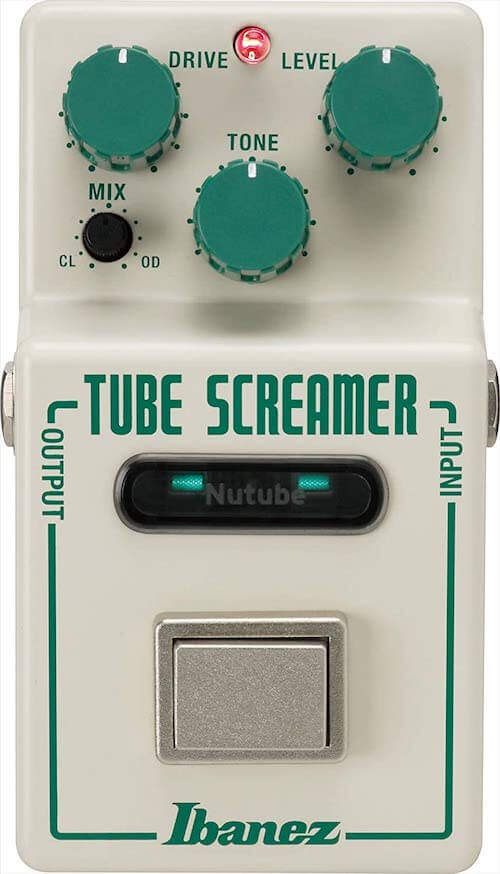
| Pros | Cons |
|---|---|
| Small footprint | The switch is not as proud as on MXR or Boss pedals |
| Strong metal chassis | The distinctive character won’t be to everyone’s taste |
| Great for lead guitar | Expensive |
| Innovative technology |
The Nu Tube Screamer claims to be the world’s first pedal, including a Korg NuTube as its primary source of overdrive.
Rather than the original Tube Screamer’s op amp section, it comes courtesy of a NuTube, which simulates the preamp tube of an all-tube amplifier.
Its natural compression and massive headroom – providing volume without distortion if necessary – are immediately apparent.
Its controls are pretty diverse, allowing tight control over the amount of gain.
It provides thick, subtle overdrive.
In fact, it’s far more subtle than the original Tube Screamer.
It provides the kind of dynamic control you’ve come to expect from a cranked tube amp.
In fact, this Ibanez Tube Screamer does not behave much like the classic Tube Screamer at all.
It has more in common with the transparent overdrives in this list than the Tube Screamer below.
Its footswitch is a square that does not stand as proud of its housing as the Boss or MXR-style pedals.
As a result, it can be a little tricky to use.
Its Mix knob offers a handy blending of the clean and dirty signals running through the amp.
This offers tighter tonal control than you’d expect from Ibanez’s little green box.
The Nutube Screamer is easy enough to use for a beginner.
It’s a warm, friendly overdrive that works well:
- Either as a source of light drive for blues or country players, or
- To kick on for solos in a rock band.
| Price: $243.28 on Amazon. |
10. Maxon Reissue Series OD808 Overdrive Pedal
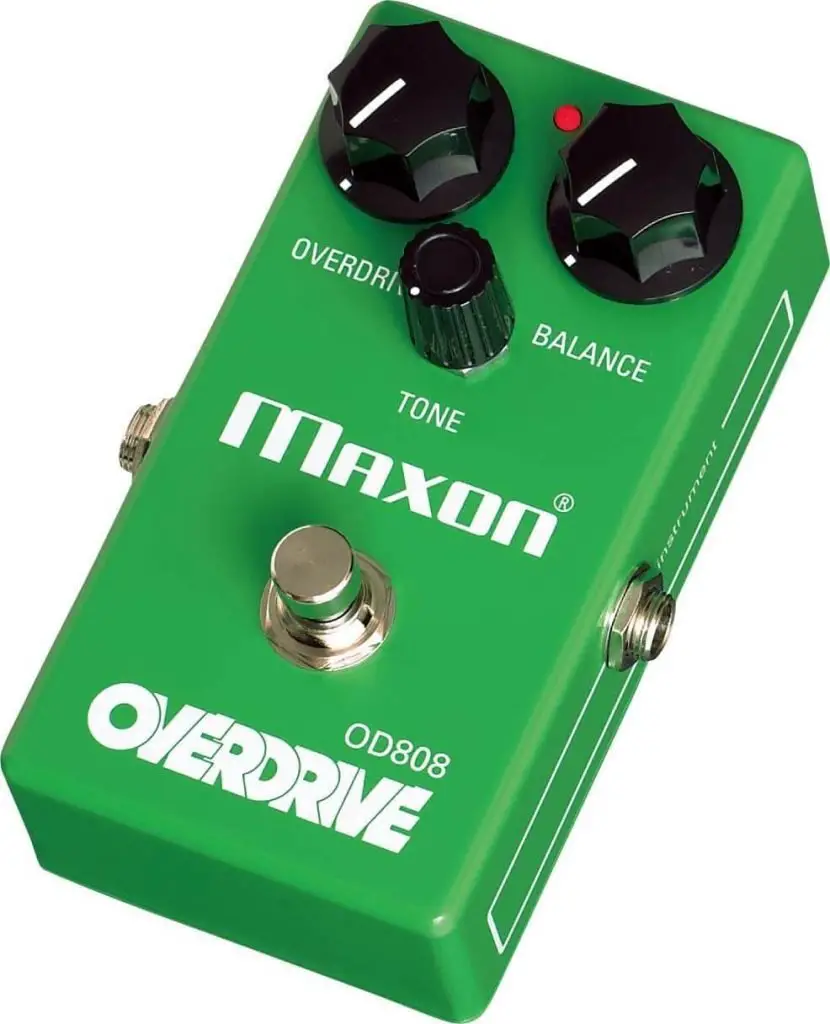
| Pros | Cons |
|---|---|
| Small footprint | Can be hard to find |
| Durable housing | Has a particular tone that might not be to everyone’s taste |
| Surprisingly diverse, great for anything from blues to metal | |
| Faithful vintage TS sound |
The second imitation Tube Screamer on this list is the Maxon OD808.
This pedal is pretty much identical to the Ibanez TS808. It even comes in the same garish green color.
Technically, the Maxon OD808 was the original design of the Tube Screamer, which was rebranded as such for Ibanez.
The OD808 will color your tone, but this might not be a bad thing.
It’s about the size of an MXR pedal and clearly took its design cues from MXR’s stompboxes.
It’s easy to use, sells for less than a vintage Tube Screamer would, and has an open, articulate sound with plenty of dynamic range.
The OD808 might be best known as a light drive…
But it’s a pedalboard staple of metalcore bands like “As I Lay Dying” and “Killswitch Engage.”
| Price: $129.95 on Amazon |
11. Ibanez TS808 Overdrive Pedal
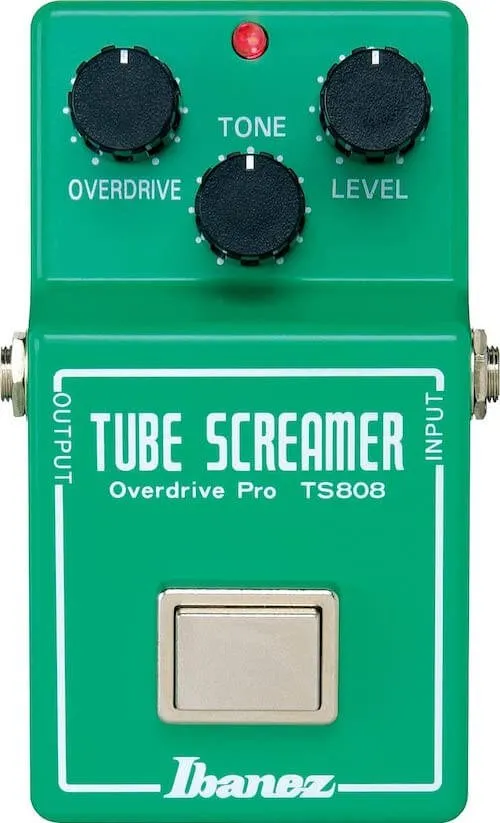
| Pros | Cons |
|---|---|
| Great dynamic range | Has a distinctive tone that might not be for everyone |
| Classic drive tone | |
| Diverse applications | |
| Easy to use | |
| It will last for decades |
Ah, the Tube Screamer…
This is Ibanez’s best-known pedal.
This little green box might be the most famous overdrive unit in the world.
The Tube Screamer was one of the first distortion pedals ever made, and it was aimed squarely at Marshall players.
If you’ve got a Super Lead-style Marshall at home, whether it’s a vintage-voiced Plexi or a high-octane JCM800, the Tube Screamer will make a great marriage with your amp.
The Tube Screamer provides plenty of dynamic range…
But it will color the tone of your guitar and amp.
It has a characteristic midrange “hump” that no amount of fiddling with EQ knobs will remove.
Some guitar players like this and lean into the sound for their lead tone.
Others dial back this pedal’s gain knob and use it as a light drive, like Stevie Ray Vaughan.
The Tube Screamer is incredibly easy to use.
It’s easy to dial in a tone or turn it on and will provide enough gain for most applications.
However, if you’re running it into a totally clean amp, you won’t be playing Slipknot.
Beginners will appreciate how quickly they can emulate famous guitar sounds…
But this isn’t just for newbies.
Stevie Ray Vaughan also used the Tube Screamer to provide the core of his tone…
So, even the most advanced players among us can find something to love about the Tube Screamer.
It’s housed in a sturdy metal chassis and provides overdrive for just about any application.
If you can get over the fact that it will, no matter what, color your tone, it’s worth owning one.
| Price: $140 on Amazon. |
12. BOSS SD-1 Super OverDrive Pedal
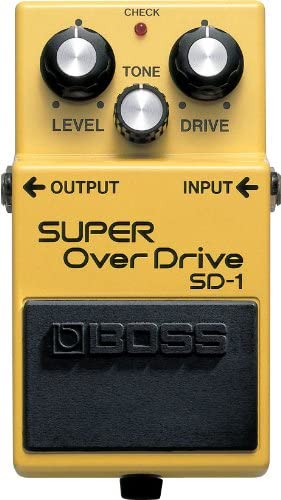
| Pros | Cons |
|---|---|
| One of the best overdrive pedals in its price range | It will color your tone even when turned off as it is not true bypass |
| Classic light drive tone | Modern iterations have a slightly different sound from more expensive vintage models |
| Great for gigging guitarists who need all-purpose drive | |
| Easy to use | |
| It will last for decades |
This simple overdrive from Boss might just be the best value for money pedal on this list.
First released in 1981, this SD-1 was one of Boss’ first guitar pedals.
It was intended as a workhorse pedal for the gigging musician.
Particularly those in regularly working bands who needed overdrive at lower volumes than amps could provide at the time.
With its sweet, harmonic asymmetrical clipping circuit, this certainly does the job.
Like all Boss pedals, the Super Overdrive is built like a tank.
It provides mild to moderate drive sounds.
Use it in front of a cranked Marshall amp, and you will achieve the searing, incendiary lead tone of Ozzy Osbourne’s late-80s axeman Zakk Wylde.
Forty years since its inception, this pedal is still a staple of working guitarists’ pedalboards.
This success is due to the pedal’s capacity to add tightness and definition to high-gain tones and its friendliness when used with other pedals.
This is a pedal best suited to intermediate players and above who are planning on playing live.
However, at its price, it could make a great first pedal for beginners.
| Price: $49.99 on Amazon |
13. BOSS DS-2 Turbo Distortion Guitar Effects Pedal
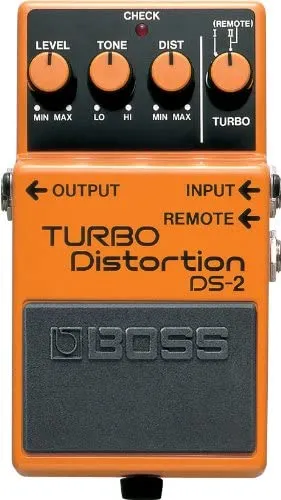
| Pros | Cons |
|---|---|
| Range of vintage and modern distortion tones for a low price | The “harshness” of this pedal’s tone might not be for everyone |
| Rugged build quality | Performs best at high volume |
| Great for gigging guitarists looking for flavored distortion beyond the usual overdrive | |
| Easy to use | |
| Provides industry-standard distortion |
Boss certainly has a knack for naming their pedals.
The DS-2 Turbo Distortion is many gain stages beyond the Super Overdrive.
It provides the kind of nasty, gnarly distorted tone that you’d expect from the 80s and 90s metal.
Reportedly, Kurt Cobain preferred the snarling sound of the DS-2 so much that he even played one for Nirvana’s seminal album Nevermind.
The DS-2 is built like a tank.
It is relatively easy to use…
And probably has the best gain-to-dollars ratio on this list.
Considering this pedal has three control knobs and an additional “turbo” knob, it has a great range of tones.
It’s great for beginners looking for their first pedal to professionals who want to add an extra flavor to their rig.
| Price: $102.99 on Amazon. |
14. Electro-Harmonix Soul Food Distortion / Fuzz / Overdrive Pedal
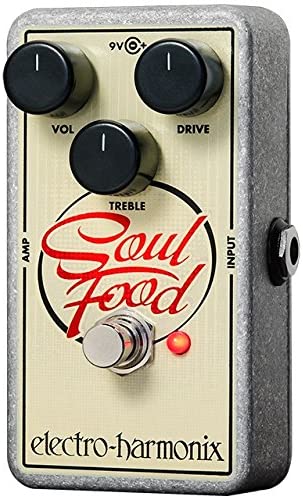
| Pros | Cons |
|---|---|
| Transparent overdrive | Can be shrill |
| Durable metal build | Lacking midrange harmonics |
| Sensitive controls | |
| Diverse tones | |
| Surprisingly affordable compared to the Klon Centaur that it’s based on |
This is the final transparent overdrive on our list, but it’s by no means in last place in terms of quality.
The Soul Food works best either as a clean boost or as the main source of dirty, in-your-face overdrive.
It will preserve all the character of your guitar and amp and provide plenty of punch and grit without compromising your tone.
Where this pedal truly shines is at high-gain settings, as it won’t lose any presence.
In fact, when used to push a high-gain amp, it will tighten up your low end and fulfill all your chugging metal dreams.
The Gain knob is very sensitive and really flatters your searing lead guitar tone.
This isn’t a good pedal for beginners as it’s very sensitive to the touch.
This pedal is perfect for intermediate and advanced players looking to either dirty up their clean sound or provide some extra kick to their already distorted tone.
| Price: $111 on Amazon |
15. BOSS Blues Driver Guitar Pedal
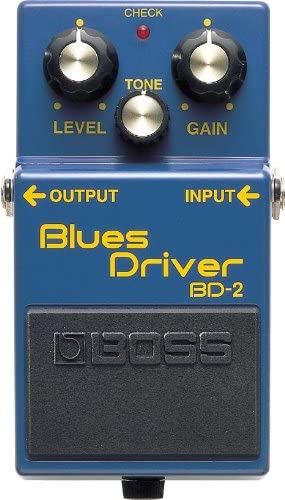
| Pros | Cons |
|---|---|
| Great for crunchy Chicago-style blues tone | Has a small amount of gain on offer |
| Durable | Not very diverse |
| Easy to use | |
| Although a little bigger than the MXR. It is comfortably small | |
| Prince used one |
This pedal is built to provide the cream and crunch of gritty, bluesy lead playing.
The Blues Driver is designed to push vintage tube amps into warm, slightly driven tone zone.
Prince, one of the greatest guitar players of all time, took to using the Blues Driver as his primary source of overdrive. Often running it in conjunction with an aggressive fuzz pedal for his lead sound.
The Blues Driver does crunch more than distortion and is best suited to players looking to specialize in blues and rock.
It won’t do much for metalheads who need massive gain on tap.
Beginner guitarists won’t get enough versatility out of this pedal.
The Blues Driver has a pleasantly diminutive footprint, although it’s a little larger than the MXR pedals on this list.
Its two controls – one for volume and one for gain – are nicely sensitive to the touch, although cranking the gain knob doesn’t add much.
Boss pedals are built to be toured, so it’s rugged and durable.
| Price: $95.83 on Amazon |
Conclusion
In this list, we provided you with pedals to suit the beginner, intermediate, and advanced players looking to add grit to their Marshall amp signal.
If we missed any overdrive pedals for marshall amps on the list let us know in the comments below!
